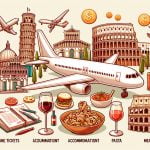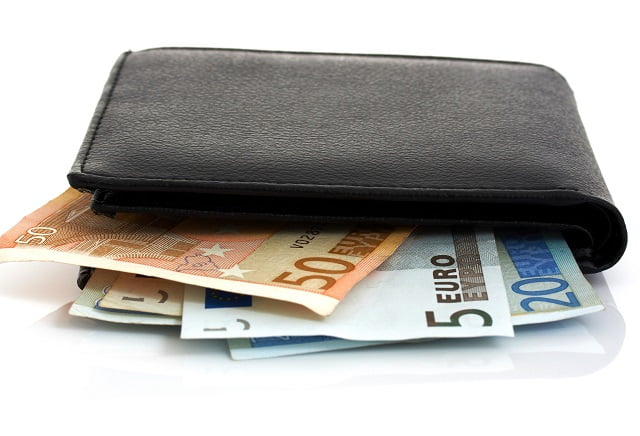Are you dreaming of exploring the wonders of Italy but wondering how much money you need to make this dream a reality? From indulging in delectable Italian cuisine to marveling at iconic landmarks, traveling to Italy can be an enchanting experience. In this article, we will delve into the various expenses you may encounter when planning a trip to Italy. Whether it’s transportation, accommodation, dining, or sightseeing, we’ll provide insights on how to budget for your Italian adventure.
When planning a trip to Italy, one of the most common questions that arises is: “How much money do I need?” This is a crucial consideration as travel costs can significantly impact the overall experience. By breaking down each aspect of traveling expenses, we aim to empower travelers with the essential information needed to make informed decisions and budget effectively for their Italian escapade.
From airfare and train tickets to hotel accommodations and dining experiences, there are numerous factors that contribute to the overall cost of traveling to Italy. Exploring these factors in depth will not only help in estimating the required budget but also enable travelers to make choices that align with their financial preferences.
So let’s embark on this journey as we unravel the costs associated with traveling to Italy and unlock valuable tips for budget-friendly travel in this captivating destination.
Transportation Costs
When planning a trip to Italy, one of the first considerations is how to get there. The cost of airfare can vary greatly depending on the time of year, airline, and departure city. On average, a round-trip ticket from the United States to Italy can cost anywhere from $600 to $1500 or more. It’s important to keep an eye out for deals and promotions to help save money on airfare.
Once in Italy, travelers have various options for getting around the country. The train system in Italy is extensive and efficient, making it a popular choice for transportation between cities. The cost of train tickets depends on the class of service and distance traveled, with tickets ranging from approximately €20 to €100 or more.
For those looking for more flexibility in their travel plans, renting a car is also an option. Rental car prices in Italy can vary widely depending on the type of vehicle and rental duration.
| Transportation Expense | Estimated Cost |
|---|---|
| Airfare | $600 – $1500+ |
| Train Tickets | €20 – €100+ |
| Rental Car (per day) | $50 – $150+ |
By budgeting for these transportation expenses, travelers can better prepare for how much money they will need to travel to Italy and ensure a smooth and enjoyable trip.
Accommodation Expenses
When planning a trip to Italy, one of the most significant expenses to consider is accommodation. Whether you prefer the comfort of a hotel, the sociable atmosphere of a hostel, or the local experience of an Airbnb, it’s important to factor in these costs when budgeting for your Italian adventure.
Hotel Costs
Hotels in Italy can vary significantly in cost depending on the city and time of year. In major tourist destinations like Rome, Florence, and Venice, expect to pay higher prices for hotels, especially during peak season. On average, budget travelers can find accommodations for around $50-100 per night for a standard double room. However, luxury hotels can easily exceed $200 per night.
Hostel Options
For those looking to save money on accommodation while also meeting other travelers, hostels are a great option. Hostels typically offer dormitory-style rooms with shared facilities, making them a cost-effective choice for budget travelers. Prices for hostel beds in Italy range from about $20-40 per night, making them an affordable alternative to hotels.
Airbnb Rentals
Another popular option for travelers is to book accommodations through Airbnb. This can be an excellent way to save money while also experiencing life like a local in Italy. The cost of renting an entire apartment or home through Airbnb varies depending on location and amenities but can range from $50-150 per night.
Regardless of your chosen accommodation type in Italy – whether it be a hotel, hostel or Airbnb – it’s essential to research and book well in advance to secure the best rates and options for your travel dates. By planning ahead and considering different options based on your budget and preferences, you’ll be able to enjoy the perfect Italian getaway without breaking the bank.
Food and Dining Expenses
When visiting Italy, one of the most anticipated and exciting aspects of the trip is exploring the country’s renowned cuisine. From pasta to pizza, gelato to espresso, Italian food is famous worldwide for its delicious flavors and variety. However, dining out in Italy can be a significant expense for travelers, so it’s important to budget accordingly.
Exploring Italian Cuisine
Italian cuisine is diverse and varies by region, with each area offering its own specialties and delicacies. From the rich and hearty dishes of the north to the fresh seafood and citrus flavors of the south, there’s something for everyone in Italy. Travelers should take advantage of this culinary diversity by trying traditional dishes such as risotto in Milan, Neapolitan pizza in Naples, or fresh seafood along the Amalfi Coast.
Dining Options
In Italy, dining options range from budget-friendly pizzerias and trattorias to upscale restaurants and Michelin-starred establishments. Travelers can save money by opting for fixed-price lunch menus or seeking out local eateries away from tourist hotspots. Additionally, street food such as arancini (rice balls) or panini sandwiches can provide a quick and affordable meal while on-the-go.
Setting a Budget
When planning for food expenses in Italy, travelers should consider setting a daily allowance for meals based on their preferences and habits. This could include allocating a higher budget for special dining experiences or leaving room for indulging in gelato multiple times a day. By researching average meal costs and creating a rough estimate of daily spending, visitors can better understand how much money they need to travel to Italy without overspending on dining expenses.
Sightseeing and Activities
When visiting Italy, one can expect to incur expenses related to admission fees for popular tourist attractions such as the Colosseum in Rome, the Uffizi Gallery in Florence, or the Vatican Museums in Vatican City. Additionally, guided tours of historical sites or cultural landmarks may also come with a price tag. For example:
- Colosseum: General Admission – €12, Guided Tour – €25
- Uffizi Gallery: General Admission – €20, Guided Tour – €50
- Vatican Museums: General Admission – €17, Guided Tour – €30
In addition to sightseeing expenses, travelers can also allocate funds for recreational activities such as hiking in the Italian Alps, taking a gondola ride in Venice, or exploring the Amalfi Coast by boat. These activities can vary greatly in cost depending on the location and type of experience desired.
It’s essential to research and plan ahead for these expenses to ensure that you have set aside adequate funds for your desired activities while traveling in Italy.
Ultimately, when budgeting for your sightseeing and activity expenses in Italy, it’s advisable to prioritize experiences that are most meaningful to you while being mindful of how much money you need to travel to Italy. By keeping an eye on potential costs and utilizing money-saving strategies such as purchasing attraction tickets online or through bundled tour packages can help make your Italian adventure more affordable without sacrificing memorable experiences.
Shopping and Souvenirs
When traveling to Italy, one of the most enjoyable aspects of the experience is exploring the local shops and markets. From beautiful handmade crafts to delicious food products, there are plenty of items to tempt you. However, it’s important to budget for shopping and souvenirs so that you don’t overspend and end up short on funds for other travel expenses.
To ensure that you stay within budget when shopping in Italy, consider these tips:
- Make a list of items you want to purchase: Before setting out to explore shops and markets, make a list of items you would like to buy as souvenirs or gifts. This will help you stay focused on what really matters to you and avoid impulse purchases that can add up quickly.
- Research prices at different locations: Different shops and markets may have varying prices for the same items. Take some time to compare prices before making a purchase, especially for more expensive items such as leather goods or jewelry.
- Set a daily shopping budget: To avoid overspending, allocate a specific amount of money each day for shopping. This will help you keep track of your expenses and not go overboard.
- Consider bringing back consumable souvenirs: Instead of purchasing trinkets and knick-knacks that may end up collecting dust, consider bringing back food or drink items that can be enjoyed with friends and family. This can also be a more affordable option than buying physical souvenirs.
By being mindful of your spending when it comes to shopping and souvenirs, you can ensure that you have enough money for other aspects of your trip. Additionally, prioritizing meaningful purchases can provide lasting memories without breaking the bank.
Additional Expenses
Traveling to Italy involves more than just the basic expenses of transportation, accommodation, food, and sightseeing. It’s important to consider additional expenses such as travel insurance, visa fees, and unexpected costs that may arise during your trip. These extra costs are crucial to factor into your budget when planning a trip to Italy.
Firstly, travel insurance is an essential aspect of any international trip. While it may seem like an unnecessary expense, having travel insurance can provide you with peace of mind in case of emergencies such as medical issues or cancellations. The cost of travel insurance varies depending on factors such as the length of your trip and the coverage options you choose.
Secondly, if you’re not a citizen of the European Union, you will likely need to obtain a Schengen visa to travel to Italy. Visa fees can vary depending on your nationality and the type of visa you need. It’s important to research the specific requirements and costs associated with obtaining a visa for Italy well in advance of your planned travel dates.
Lastly, unexpected costs can easily arise during any trip, so it’s wise to budget some extra money for unforeseen expenses. This could include things like transportation mishaps, lost or stolen items, or sudden changes in plans that incur additional costs. By setting aside a buffer for unexpected expenses, you can avoid financial stress if these situations arise during your time in Italy.
Considering these additional expenses is crucial when determining how much money you need to travel to Italy. Travel insurance, visa fees and unexpected costs are all important factors that contribute to the overall cost of visiting this beautiful country.
| Expense | Average Cost |
|---|---|
| Travel Insurance | $50 – $200 (depending on coverage) |
| Schengen Visa Fees | Varies by nationality (average $60 – $90) |
| Unexpected Costs | Plan for at least $200-$300 as a buffer |
Tips for Budget Traveling
In conclusion, traveling to Italy can be an incredibly rewarding experience, but it’s important to carefully consider the costs involved in order to make the most of your trip. From transportation and accommodation to food, sightseeing, and shopping, there are numerous expenses to factor into your budget. By considering these factors and planning ahead, you can better estimate how much money you need to travel to Italy.
When it comes to transportation costs, it’s worth researching different options for airfare, train tickets, and rental cars in order to find the best deals. Accommodation expenses can also vary depending on whether you choose a hotel, hostel, or Airbnb option. Additionally, exploring Italian cuisine and dining options is an integral part of the experience but can also impact your budget if not planned for accordingly.
In addition to these planned expenses, it’s essential to consider additional costs such as travel insurance and potential visa fees. It’s also wise to budget for unexpected costs that may arise during your travels.
By being mindful of these various expenses and implementing money-saving strategies and tricks for traveling on a budget in Italy, you can make the most of your trip without breaking the bank. Ultimately, with careful planning and consideration of all potential expenses, you can have a fantastic and memorable experience in Italy without overspending.

I’m a passionate traveler, writer, and Italophile. My fascination with Italy’s history, art, and culture has led me on countless adventures across the Italian landscape. Through “I Live Italy,” I share my love for this extraordinary country and aims to inspire others to explore its boundless beauty.





